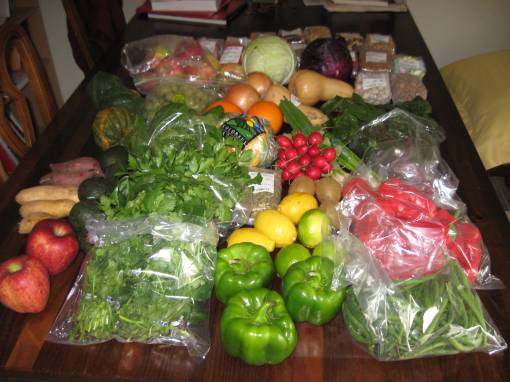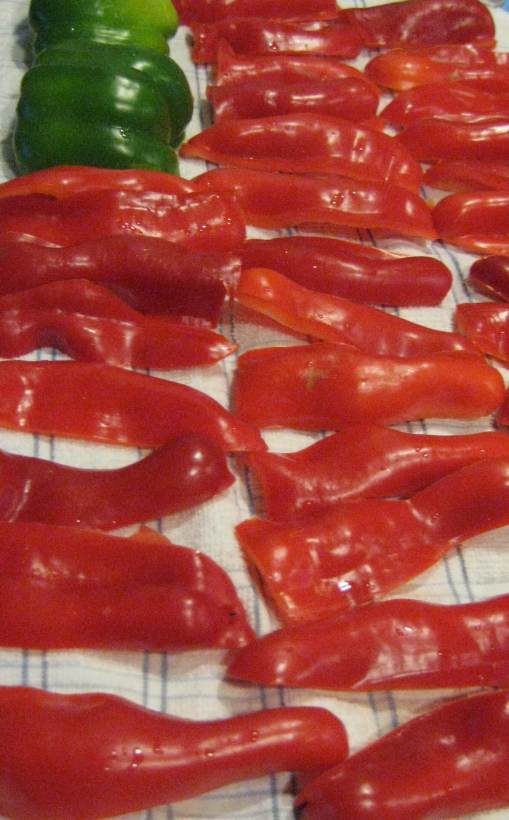Continued from prior post…
Stop 3: Warren, Ohio, Aug 4-7. My mom, sister and niece had joined me in Baltimore and they participated in some of the Goucher weekend festivities, and then we all drove back together to Ohio on Monday, Aug 4.
That evening, we were to visit my uncle who lives out in the countryside near where I grew up (in northern Trumbull County – land of farms and the Amish). My sister and I were both exhausted and didn’t want to go, especially after a five-hour road trip from Baltimore. But we all went, and I was so happy that I did. The purpose of the visit was to see family and to fish. My aunt and uncle have a large garden, a fenced pasture where my uncle currently keeps two small calves that he will either have butchered or sell, and a well-stocked pond. My uncle reminds me of my grandfather as I knew him: gentle, patient, observant, and in tune with the ecosystem of his land.
I had never fished. My uncle just kept making the rounds, baiting everyone’s hooks (I quickly became brave enough to do it myself with worms, but the maggots still kind of grossed me out), and I sat and watched the surface of the pond. It turned out to be the best way to relax after nearly five days of non-stop socializing and travel. We were there before dusk, and stayed until the sun dropped below the horizon. I’ve been realizing lately how much I miss the land and space of my childhood, and being closer to nature in general. This was a great fix: sitting around a pond, talking and learning about fishing, listening to the crickets, watching the birds and bats, and watching the sun set over the fields. I caught two small blue gills and a 21” catfish, which were all thrown back…for now. Until my uncle and aunt host their next fish fry.
The remainder of my Ohio visit included a birthday excursion (my entire family is Leo) to see the Broadway touring show of Mamma Mia (which I wrote about previously), a party that I hosted for my local friends, and cleaning out my mother’s garage!
It was great to see old friends on Wednesday night: Chris, Karyn & their daughter Emma (who is 3 and I met for the first time); Becky, Doug & their kids; Barb, Melinda, Lana, Eric, and Christine. It is always difficult to find the time to see friends when I am in Ohio, so I was especially grateful that so many of them made the effort to drive in on a weeknight from Cleveland and Akron.
My sister and I planned to tag-team my mom, and on Thursday the three of us cleaned out her garage, the last “problem area” in her home that is currently up for sale. It was a Herculean task, but one day of hard work and trips to recycling and Goodwill gave my mom a garage with double the space and a clutter-free world. She recently confessed, giddily, that she left her garage door open the other day while she was at home and was not ashamed.
My visit ended with my 7-year-old niece yelling out the car window, as they drove away that evening, “Stay here forever; don’t leave” over and over again. It is difficult to part ways at times.
Stop 4: New York City & Noroton Heights, CT, Aug 8-10. I had an early-morning flight to NYC on Friday. I hadn’t been back to New York since M. and I briefly lived outside of the city two and a half years ago (a 10-week sublet in Hastings-on-Hudson, before we decided to move back to California where all our furniture and belongings still lived). I dropped off my luggage at my friend C.’s office near Astor Place, and hit the pavement.
I am always happy to just roam around the city, walking, and getting on and off the subway. I walked up Broadway, stopped at Strand Books (obligatory), and then headed to museum mile with the idea that I visit at least one museum. I hadn’t been to the Guggenheim in a long time, but upon seeing the mass of people standing in line inside, I quickly retreated and continued my walk up 5th Ave.
The National Academy Museum was currently hosting their 183rd Annual: An Invitational Exhibition of Contemporary American Art. Originally the home of a railroad magnate, this museum is more intimate in scale and, with my background in American art history, I have always enjoyed my visits there. The galleries are on the 2nd and 4th floors and consist of a series of small and large rooms, which I primarily had to myself. My favorite piece was “Self Portrait with Men in Hats 2007” (below) by Julie Heffernan, and seeing it was worth the visit.

I met my friend M.C. that evening for dinner. He has an amazing rent-controlled apartment in Hell’s Kitchen, complete with views of the mid-town skyline. M. is a member of my Goucher class who is successfully building a career in the greening of the arts (read this recent article he wrote on the greening of Broadway). He, his friend J. and I shared a great bottle of wine and small plates at Xai Xai, a South-African wine bar.
On Saturday, I spent a wonderful day with my friends C. & T. just kicking around in CT (it was a much-needed low-key day!). T. cooked for us in the evening; he grilled clams and halibut, seasoned with fresh herbs from their garden, and it was phenomenal. We have always bonded over our mutual love of cheese and wine, and our meals together are always memorable, delicious, and inevitably end with a few-too-many empty wine bottles.
Sunday morning was equally fabulous: coffee, bagels, and the Sunday Times on the deck, in the company of wonderful friends.
And then I came home.

 So I spent all of the afternoon before Thanksgiving (and into Thanksgiving day, as well) washing, cutting, and storing vegetables and herbs. In the week and a half since then, my roommate and I have used all the fresh things, and I take pleasure in being able to pull a ziploc full of clean, ready-to-use cilantro from the freezer when making guacamole.
So I spent all of the afternoon before Thanksgiving (and into Thanksgiving day, as well) washing, cutting, and storing vegetables and herbs. In the week and a half since then, my roommate and I have used all the fresh things, and I take pleasure in being able to pull a ziploc full of clean, ready-to-use cilantro from the freezer when making guacamole.